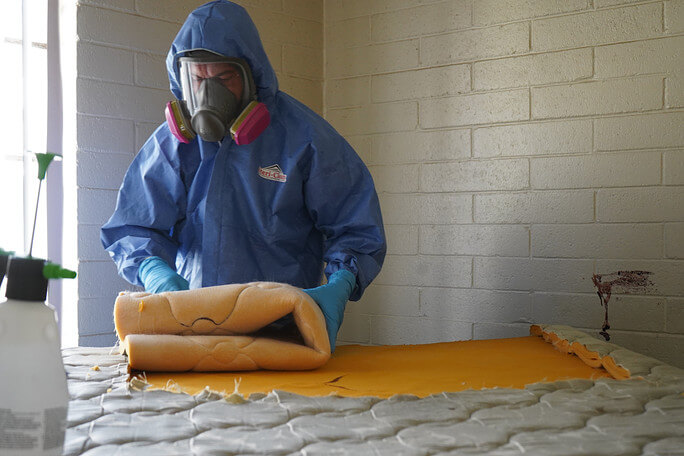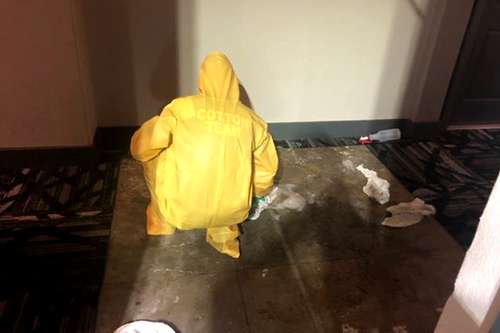Sewage Cleanup Services: Fast and Safe Remediation of Contaminated Areas
Sewage Cleanup Services: Fast and Safe Remediation of Contaminated Areas
Blog Article
Professional Biohazard Cleansing and Decontamination for Blood, Bodily Fluids, and Hazardous Materials
The prospective health dangers linked with direct exposure to biohazards highlight the essential need for meticulous handling and comprehensive clean-up. As we navigate the detailed landscape of biohazard cleaning, comprehending the subtleties of regulations, compliance, and the specific tools at play becomes critical in guaranteeing a comprehensive and risk-free purification procedure.
Health Risks of Biohazard Exposure
Exposure to biohazards presents considerable wellness threats that can cause severe consequences for individuals and communities alike. Biohazards incorporate a wide variety of organic substances, including blood, physical liquids, mold and mildew, microorganisms, infections, and various other possibly transmittable products. When people enter into call with these biohazards, whether with mishaps, incorrect handling, or environmental exposure, they face the risk of having significant illnesses or diseases.
Among the key wellness threats connected with biohazard direct exposure is the transmission of transmittable illness. Bloodborne microorganisms such as HIV, hepatitis B and C, and different germs can be present in biohazardous materials, presenting a direct threat to human health. Inhaling airborne biohazards like mold and mildew spores or coming right into call with polluted surfaces can additionally cause breathing issues, allergic reactions, and other unfavorable health results.
Moreover, biohazard exposure can have lasting health and wellness implications, with some conditions materializing years after the initial call (Blood Cleanup). As a result, it is important to prioritize correct biohazard cleaning and purification to reduce these health threats and guarantee the safety of areas and people

Specialized Training for Biohazard Cleaning
When it comes to dealing with biohazard cleaning efficiently and safely, specialized training plays a basic duty in ensuring correct purification procedures are complied with. Biohazard clean-up calls for particular expertise and skills to efficiently reduce dangers connected with bloodborne pathogens, bodily liquids, and unsafe materials. Experts educated in biohazard cleaning undergo rigorous instruction on exactly how to safely deal with, eliminate, and dispose of biohazardous products to avoid contamination and exposure.
Specialized training for biohazard cleanup covers a range of vital topics, including proper personal protective devices (PPE) use, bloodborne pathogen awareness, purification techniques, and dangerous waste disposal procedures. People learnt biohazard clean-up are geared up with the required experience to analyze contamination degrees, determine prospective risks, and implement ideal cleaning procedures in conformity with governing requirements.
Continuous training and education and learning are extremely important in the area of biohazard clean-up to stay upgraded on the current decontamination technologies, safety and security procedures, and policies. By investing in specialized training, biohazard cleaning experts can effectively react to emergency cleanup scenarios and secure both public health and the setting.
Value of Proper Purification Methods
Using correct decontamination techniques is critical in biohazard clean-up to effectively get rid of dangerous products and reduce health dangers. Effective purification not only makes sure the removal of noticeable traces of blood, bodily liquids, and other biohazards however also targets unseen microorganisms that might pose severe health dangers otherwise correctly gotten rid of. By following rigid purification protocols, trained specialists can dramatically decrease the danger of direct exposure to harmful bacteria, infections, and bacteria that could cause infections or conditions.
Appropriate decontamination strategies entail making use of specialized devices and anti-bacterials that are especially designed to reduce the effects of biohazards successfully. Extensive cleansing and sanitation of contaminated areas are vital to stop the spread of virus and make certain a safe try this site environment for passengers. Furthermore, the right disposal of biohazardous waste adhering to purification treatments is essential in preventing contamination of other surfaces or individuals.

Tools and Devices for Safe Clean-up
When dealing with blood, physical liquids, or hazardous products, biohazard cleaning professionals count on specialized equipment to lessen direct exposure dangers and completely decontaminate the affected area. In addition, biohazard cleansing kits consisting of disinfectants, absorbent materials, and biohazard bags are used to securely have and dispose of contaminated items.
Advanced cleansing devices like hospital-grade anti-bacterials, HEPA-filtered vacuums, and misting devices are used to disinfect surfaces and get rid of biohazards efficiently. Specialized tools such as sharps containers and biohazard waste disposal bins are used to securely handle sharp things and biohazardous waste products. By making use of the right equipment and tools, biohazard cleaning experts can make sure a comprehensive clean-up process that prioritizes security and lessens health and wellness dangers for both employees and passengers of the damaged area.
Laws and Conformity in Biohazard Cleaning
Appropriate adherence to policies and compliance requirements is critical in biohazard cleaning to guarantee the safety of both personnel and the environment. Government firms such as OSHA (Occupational Safety And Security and Wellness Management) and the EPA (Environmental Defense Company) have established specific guidelines for biohazard cleaning treatments to lessen health and wellness dangers and environmental contamination. These regulations cover a variety of elements including the handling, transportation, and disposal of biohazardous products, along with the needed training and protective equipment needed for workers associated with the cleanup procedure.
Biohazard cleaning companies should stay current with these guidelines to assure that their procedures satisfy the required safety criteria. Failure to abide by these laws can lead to extreme repercussions, including penalties, lawsuit, and threatening the wellness of individuals and the environment. By complying with stringent laws and compliance actions, biohazard hop over to these guys cleaning firms can efficiently minimize dangers and ensure a risk-free and thorough clean-up procedure for all parties entailed.
Conclusion
Finally, biohazard cleaning and decontamination call for specialized training, appropriate strategies, and adherence to policies. Direct exposure to blood, physical fluids, and harmful products poses considerable wellness risks, making it vital to use the best devices and devices for safe cleanup. By complying with rigorous methods and guidelines, experts can successfully minimize the threats related to internet biohazard exposure and make sure the safety and security of both themselves and others.
As we browse the intricate landscape of biohazard cleanup, comprehending the nuances of guidelines, conformity, and the customized tools at play becomes necessary in ensuring a extensive and risk-free purification procedure. (Blood Cleanup)
When it comes to managing biohazard cleaning successfully and securely, specialized training plays a basic duty in making certain correct purification treatments are complied with.Using proper decontamination techniques is crucial in biohazard cleaning to properly reduce and eliminate hazardous materials wellness risks. Additionally, biohazard cleansing kits having disinfectants, absorbing materials, and biohazard bags are utilized to securely dispose and contain of contaminated things.
Government companies such as OSHA (Occupational Safety And Security and Health Administration) and the EPA (Environmental Defense Company) have established certain standards for biohazard cleanup procedures to lessen wellness threats and environmental contamination.
Report this page